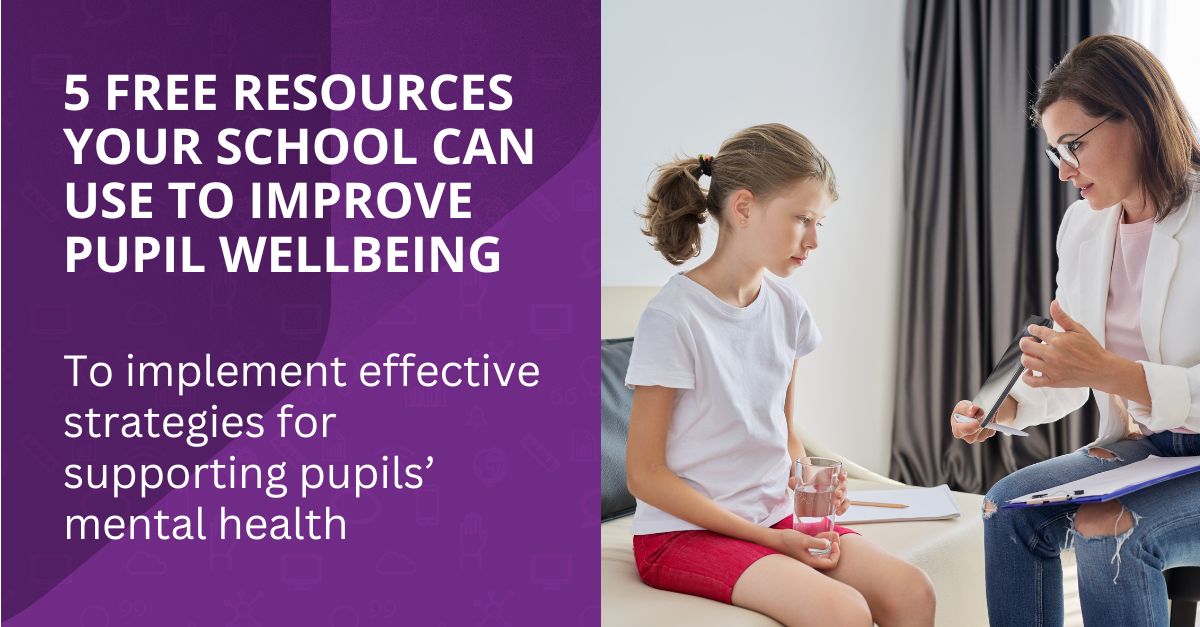Pupil wellbeing is crucial for academic success, personal development, and mental health. According to the University of Oxford Impact Study, pupil wellbeing is influenced by various aspects of school life, such as curriculum, assessment, relationships, environment, and support. Therefore, a holistic and evidence-based approach is advisable for schools and trusts seeking to promote wellbeing.
In this blog, we will introduce five resources that you can use to improve pupil wellbeing:
- Oxford Impact: a resource for planning your wellbeing strategy
- 5 Steps to Wellbeing: a resource to address pupil wellbeing at the school level
- Classroom Wellbeing Toolkit: a resource for teachers to support pupils
- YoungMinds Stress Bucket: a resource for pupils to better cope with stress
- Britain Get Talking: a resource for parents to start conversations about wellbeing with their children
These resources are based on the latest research and best practices in the field of education and mental health. They are designed to help schools implement effective strategies and interventions to support pupils’ emotional, social, and psychological needs.
Oxford Impact
Based on the findings of a recent study by Dr. Ariel Lindorf from the University of Oxford, here are some evidence-based approaches to planning a pupil wellbeing strategy for your school or trust:
- Adapt to and consider your specific school context: Conduct proper self-evaluation before implementation to identify and address the school’s strengths and assets as well as the issues that need to be solved
- Adopt a whole-school approach (integrated, cross-level): Make sure that broader school policy aligns with implementation
- Involve the wider community, including parents and families
- Emphasise professional development for teachers to assist them with implementation
- Establish monitoring systems to track and modify implementation as required
- Provide adequate time and resources to facilitate implementation
A key part of this framework is encapsulated in adopting a “whole-school approach,” and the next resource provides tangible information for schools that want to adopt it.
5 Steps to Wellbeing
The 5 Steps to Wellbeing resource from Anna Freud is a practical guide for schools to promote a whole-school approach to positive mental health. The resource is based on a framework which suggests five steps to improve wellbeing:
- Leading change: having a school-wide ethos that ensures that wellbeing policies are aligned
- Working together: including parent and pupil voices when working on wellbeing
- Understanding need: measuring wellbeing and developing interventions
- Promoting wellbeing: integrating wellbeing across curriculum and school culture
Supporting staff: surveying, supporting, and training staff on wellbeing
Source: Anna Freud
The 5 Steps to Wellbeing resource provides examples, tips, and activities for each step, as well as links to further resources and support. It can also help schools to identify and address the barriers and challenges that may affect wellbeing, such as stress, anxiety, and isolation.
Classroom Wellbeing Toolkit
The Classroom Wellbeing Toolkit from Anna Freud is a collection of resources and activities for teachers to use in their classrooms to support pupil wellbeing. The toolkit provides guidance on responding to stress, low mood, and anxiety and preventing bullying. Each section contains various resources and activities suitable for different ages, abilities, and contexts.
Source: Anna Freud
The Classroom Wellbeing Toolkit can help teachers integrate wellbeing into their everyday teaching practice by providing them with easy-to-use and engaging resources and activities. It can also help teachers to foster a positive and supportive classroom environment where pupils feel safe, respected, and motivated.
YoungMinds Stress Bucket
The YoungMinds Stress Bucket is a simple and effective tool for helping pupils understand and manage their stress levels. The resource uses the metaphor of a bucket that can fill up with stressors, such as homework, exams, peer pressure, family problems, etc. The resource also introduces the concept of coping strategies, such as relaxation, exercise, hobbies, talking, etc., that can help to empty the bucket and reduce stress.

Source: YoungMinds
The Stress Bucket can help pupils recognise and express their feelings of stress in a visual and interactive way. It can also help pupils practice healthy and positive ways to cope with stress by encouraging them to find what works best for them. YoungMinds provides lots of free tools for pupils of different ages, and this resource is just one example.
Britain Get Talking
The Britain Get Talking is a campaign and a resource that aims to encourage pupils and families to talk more and listen better to improve their mental health and wellbeing. The resource is a simple exercise that asks: “What’s on our minds can be the hardest subject. So what’s on yours?” By filling out a free downloadable booklet, parents and their children can participate in a shared activity that opens the door to improving wellbeing.
Source: Britain Get Talking
Schools can recommend the Britain Get Talking homework exercise to parents who are interested in supporting their child's mental health and wellbeing. It can also help schools strengthen their links with families and communities by supporting them to have more meaningful and positive interactions.
What’s Next?
We hope this blog has inspired and guided you on improving pupil wellbeing in your school or trust. If you found this blog useful, it is clear that you are interested in evidence-based approaches to addressing pupil wellbeing. As part of next steps, consider:
- Investigating the data your school or trust collects on pupil wellbeing and selecting the resources most appropriate based on your needs
- If your organisation does not yet collect data, learn more about what you could gain by running our Pupil Learning Experience and Wellbeing Survey
- Reading Pupil Wellbeing in Schools to understand national trends in pupil wellbeing from 2020 to 2023

No comments.